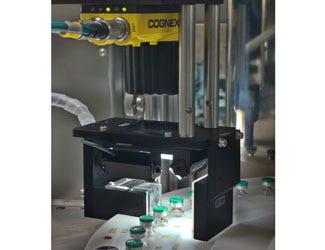High speed pharmaceutical glass- vial inspection
January 30, 2014
Few industrial sectors have such stringent quality requirements as the pharmaceutical industry. To meet these exacting specifications, companies are increasingly utilizing intelligent vision systems.
For over 30 ye
EISAI.jpg
ars, EISAI Machinery GmbH, Cologne, Germany, has been an expert in the field of high speed pharmaceutical product testing. Its latest device, the AIM 596, can inspect delicate glass vials in fractions of a second, thanks to two In-Sight vision systems from Cognex Machine Vision Systems.
Depending on the application and customer requirements, the machine can check approximately 6,000 packages and in its fastest version, the device, with its imposing inspection towers and star wheels, can test up to 12,000 units per hour.
A careful gaze
In the first inspection step, the In-Sight 5600 vision system determines the cake height of the freeze-dried contents and detects the presence of any foreign objects on their surface. At the same time, it looks for "splashings" or splatters caused by unwanted boiling during the freeze-drying process.
A standard industrial camera then looks for foreign particles on the outside of the cake and cracks, scratches or air pockets in the glass.
These first two camera systems are attached to a semicircular bracket that moves by an oscillating drive. It is here that the In-Sight 5600 demonstrates one of its key advantages: its robustness. The injection-molded aluminum and stainless-steel housings make the In-Sight impervious to vibration stresses. Another outstanding feature of the vision system is its speed. At a standard resolution of 640 x 480 pixels, it works at up to 60 frames per second, and in partial-scan mode, it can even reach up to 200 frames per second.
Zero tolerance for cracks
An additional In-Sight 5600 inspects the underside of the glass vials for cracks. For freeze-dried products, the vision system also checks the vials for unwanted particles and "meltbacks" (condensate residue that can arise during the freeze drying process of protein-containing substances).
In the AIM 596, EISAI developers work with the In-Sight Explorer software to create a user interface customized to the customer's requirements. In the event of product changes, machine operators can access preconfigured files stored in an online database without problem. New test parameters are transmitted to the vision systems with just a few clicks.
A secure fit on the glass edge
Before proceeding to the final test, an In-Sight 5400C checks both the vial cap and the flip-off seal. The inspection criteria include checking the presence of the parts, the color of the cover and, for aluminum caps, the correct processing of the crimp. As the glass containers rotate 360 deg, the In-Sight 5400C checks that the aluminum sleeves have been fitted completely around the edge of the glass and the stoppers are tightly inserted.
The second inspection tower of the EISAI SD system checks liquid products for the presence of foreign particles. The rotating containers are stopped abruptly, leaving the liquid in rotation. In the middle of the glass vials, the liquid rotates rapidly and rises while, to the outside, its speed is slower and it sinks. This causes a particle to pass through the inspection area several times. To check for particles, a focused halogen light beam illuminates the glass vials and strikes a photo sensor.
Error-free sorting
After exiting the test stations, the glass vials are conveyed by star wheel to the final sorting station. Defective products are sorted into various trays, depending on the nature of the defect. Products that pass the testing process are forwarded to a labeling or packaging machine. Only the glass vials with 100 percent product quality enter the pharmaceutical wholesale chain and are distributed to clinics, pharmacies, and medical practices worldwide.
Source: Cognex Machine Vision Systems, 508-650-3000. www.cognex.com
About the Author(s)
You May Also Like


